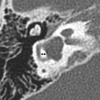Pediatric sensorineural hearing loss, part 1: Practical aspects for neuroradiologists
- PMID: 21566008
- PMCID: PMC7964818
- DOI: 10.3174/ajnr.A2498
Pediatric sensorineural hearing loss, part 1: Practical aspects for neuroradiologists
Abstract
SNHL is a major cause of childhood disability worldwide, affecting 6 in 1000 children. For children with prelingual hearing loss, early diagnosis and treatment is critical to optimizing speech and language development, academic achievement, and social and emotional development. Cross-sectional imaging has come to play an important role in the evaluation of children with SNHL because otolaryngologists routinely order either CT or MR imaging to assess the anatomy of the inner ears, to identify causes of hearing loss, and to provide prognostic information related to potential treatments. In this article, which is the first in a 2-part series, we describe the basic clinical approach to imaging of children with SNHL, including the utility of CT and MR imaging of the temporal bones; we review the most recent proposed classification of inner ear malformations; and we discuss nonsyndromic congenital causes of childhood SNHL.
Figures











References
-
- Billings KR, Kenna MA. Causes of pediatric sensorineural hearing loss: yesterday and today. Arch Otolaryngol Head Neck Surg 1999; 125: 517– 21 - PubMed
-
- American Academy of Pediatrics, Joint Committee on Infant Hearing. Year 2007 position statement: principles and guidelines for early hearing detection and intervention programs. Pediatrics 2007; 120: 898– 921 - PubMed
-
- Harrison M, Roush J, Wallace J. Trends in age of identification and intervention in infants with hearing loss. Ear Hear 2003; 24: 89– 95 - PubMed
-
- Buchman CA, Adunka OF, Zdanski CJ, et al. . Hearing loss in children: the otologist's perspective. In: Seewald RC, Bamford JM, eds. A Sound Foundation Through Early Amplification: Proceedings of the Fourth International Conference. Basel, Switzerland: Phonak; 2008: 63– 77
-
- Brenner DJ, Hall EJ. Computed tomography: an increasing source of radiation exposure. N Engl J Med 2007; 357: 2277– 84 - PubMed
Publication types
MeSH terms
LinkOut - more resources
Full Text Sources
